How to catch undulate ray, our comprehensive guide on everything you need to know to catch an undulate ray from the boat or shore.
Arguably, the undulate is the most distinctive and prettiest ray the angler can catch. The highly distinctive patterning and markings evident on its back has seen it acquire the nick-name “the pop art ray” as the coloured patterning looks very much like modern art.
Due to this rays localised distribution and late maturity and therefore being vulnerable to commercial overfishing, its numbers have been much reduced over the past three decades, some say by 80%, and since 2009 it has been illegal to retain undulates, and they must be returned alive to the water. There are though signs that their numbers are gradually increasing.
The Irish Specimen Fish Committee, a superb organisation that sets the specimen weights for Irish angling removed the undulate for some time from its specimen awards list but has since reinstated this ray on a measured length only scale allowing specimens to be claimed but the ray returned alive immediately after capture.
A rarely seen fact about the undulate is that it is not really a ray. The undulate has fins on the tail indicative of skate species, whereas true rays have whip-like tails with no fins.
As already suggested, this is a very distinctive ray and frankly, it’s almost impossible to confuse this ray with any other.
The wing edges at their peak are rounded. The back is covered in prickles though these are absent on the rear edges of the pectoral and pelvic fins. The snout is short, has prickles on it, and tends to look slightly transparent. The jaws are armed with crushing plates comprising three different types of teeth, wedged, pointed and chisel-shaped designed to crush and chew through different types of hard material including hard crustacean shells and fish flesh. The underside of this ray is smooth. Smaller undulates have a continuous row of spines down the backbone, whereas in adult fish this is interrupted, plus they have irregular rows of spines evident down the sides of the tail. The dorsal fins at the end of the tail are widely separated and can have spines in between, and as previously mentioned identify this as a true skate, though it is always referred to as the undulate ray.
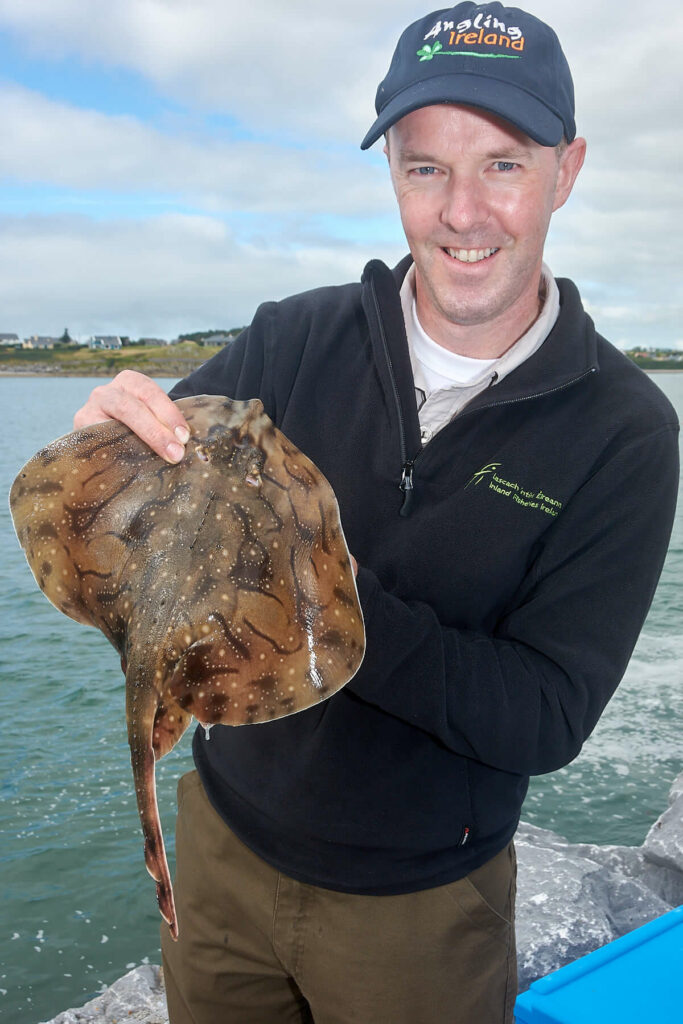
The back of this ray is usually a yellowish brown to mid brown with darker blotches, sometimes the back is overall darker brown if living in among mud patches and broken rough ground. Look for the distinctive wavy dark banding edged with white or yellowish spots that covers both wings. The belly is white, sometimes tinged with grey.
Little is really known about undulate ray’s habits, but they produce young that are inside protective egg capsules measuring up to 2ins including the horns and are an opaque reddish brown. The eggs are probably deposited in weed beds and on rough structure via the tendrils. This occurs in late summer in the UK, but in spring in the warmer waters of the Mediterranean.
It is thought that undulate rays can live up to twenty years old and achieve weights exceeding 25lbs, though this is rare. Males are mature at around seven years old, but females don’t reach maturity until nine years. They can lay up 90 eggs over a protracted period with the young hatching within three months, and they leave the egg sacs as perfectly formed, free swimming, tiny rays.
Undulates are found from North Africa, inside the western portion of the Mediterranean, and up the European coast as far as Holland.
In the UK they are found throughout the English Channel, and in the last decade, their numbers have increased along the Sussex and Kent coast showing as far as the North Foreland. They are caught off the Hampshire coast, also off Dorset, Devon and Cornwall. The textbooks tell us they are found in the southern Irish Sea too, but they are rare here. Wales has no official record for a boat or shore caught undulates on its record list.
In Ireland, again they are confined to southern shores, mainly west Cork but especially the Tralee Bay area of Kerry.
The main thing to remember regard’s undulate rays is that they are very localised in their distribution. They exist in small pockets and are often non-existent just a few miles away. This again makes them very vulnerable to overfishing. Treat them as a localised coastal fish and you won’t go far wrong.
This ray can tolerate almost estuarine conditions and indeed, is often found in sea areas adjacent to estuary environments where freshwater is lightly mixed with saltwater, an example being Fenit harbour inside Tralee Bay, Kerry and the Hampshire coast.
They are lovers of sand, but more so mud or a mix of the two and favour depressions in the mud and sand where they can sit with the tide flowing over the top of them. They can also be found in broken ground where there is a mix of mud, sand and rougher patches. They also like to lay up just off the edge of the tide close to hard rock and man-made structure, but with a clean seabed.
Undulates can also be found in areas where fine shingle sits among mud or sand, especially so if the shingle has formed an inclined bank as they like to sit on this facing into the tide and pick off small fish that are pushed towards them by the flowing tide.
Inshore they are found in depths as little as a few feet, though this is not too common. Offshore their liking is for a depth of around 20-metres, but they are found as deep as 200 metres.
A true predator that is adept at ambushing passing prey smothering it with their wings then shuffling over the capture to position it in the mouth.
They are really only fish eaters taking typically small pouting, poor cod, whiting, gobies, sandeel, and squid as there is some indication, they will swim up off the bottom some distance to intercept a shoaling food source.
They also take crustaceans, especially crabs when working tight in along the shoreline where rocks and weed dominate the low water line with access to sand or mud close in.
Undulates will sometimes surprise and individual fish can turn up either side of Christmas during mild winters. Traditionally though, April is the start of the main season when fish start to move back tight inshore and their numbers increase quickly. May and June can be excellent months, July and August can see a slight reduction in catches, maybe because the fish spread out slightly more, but September, October and early November can again see some major catches, especially of the bigger fish over 8lbs.
As we’ve established, undulates do not move out of their preferred locality, but they do move in and out with the tides, especially along the deeper beaches and inside larger bays and inlets. Their movement is less on the smaller neap tides when they tend to stick to the deeper areas close to shore or seek out areas where the tide run is flowing that bit quicker, such as an area where a bottleneck occurs or where a deeper channel carries the main tide run.
During bigger spring tides, they will travel much further and have a habit of working tight into rocky shores but will also favour deeper channels that cut into bays and inlets. They use the channels in the early flood to travel, then spread out into shallow water as the depth increases with the flooding tide. They don’t hang around though, when the tide starts to ease towards high water. This triggers them to quickly move back out into the deeper channels where they will slowly drop back as the ebbing tide retreats. They also like any deeper depressions in the seabed and will sit in these when not actively feeding. If you can locate these and cast into it, then you can continue to catch as the fish can be concentrated in numbers.
When fishing shallower areas, be prepared to keep one rod out in any deeper channels. Not only do the rays use these as transit routes, but some will often stay in these and feed working gradually in with the flowing tide, then back out again.
The best periods of the tide then, are the hours from 1.5 hours after low to 1.5 hours before high, and the middle three hours of the ebbing tide. Generally, low and high water slack when there is little if any tide run then bites slow right down.
On the more exposed open coast beaches undulates are lovers of semi settled conditions. Periods of light to moderate onshore winds are good, even light offshore winds can fish well, but periods of rougher seas will see the bulk of the fish move off into less turbulent water.
In more sheltered areas, where sea conditions are not affected too much by strong winds, then the fishing can remain good, but what they don’t like is water full of sediment for long periods. This tends to push them off to deeper waters with the seabed depressions often their home until conditions improve.
This is another fish that when entering shallower water, it prefers days with overcast cloud and subdued light levels. These are the days when they will work quite close to a rocky weedy shore. They can be caught on days with bright sunshine, but in shallow water catches will be less. Light levels and bright sunshine are less of an issue when fishing beaches with a decent depth of water, tight in, say 15ft or more.
The best time for catching undulates is dusk and dawn. They seem more active in these low light level periods. They can also be caught in the dark, too.
Casting distance and tide run will normally demand a standard beachcaster rated 4-6ozs and between 12ft and 13ft long. Suitable reels are typically the Penn525 Mag series as this reel has the distance ability, but also the line capacity to up the line breaking strain to 22lbs if you’re fishing among broken ground. On beaches with little in the way of snags, then stick to the same reel but load with 18lb line, when greater distance is needed an Abu 6500 reel, Penn Mag4 or an Akios, Shimano or Daiwa equivalent loaded with 15 to 18lb line can gain those extra yards. A 60lb shock leader completes the outfit.
If you’re a fixed spool user, then the European 14ft rods matched to a 7000 or 7500 reel, such as the Penn Spinfisher or Affinity will get you maximum casting range for the minimum effort. Load the reel with 30lb braid and add either a tapered shock leader or, better still, an 80lb braid leader connected to the 30lb by back to back grinner knots.
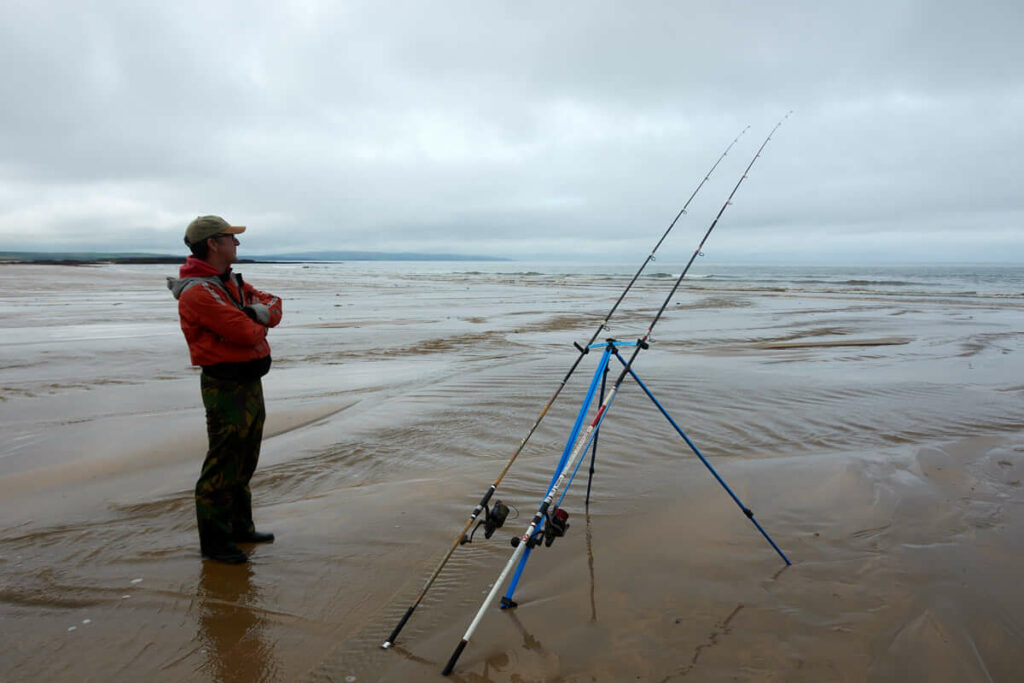
Most rays, and the undulate is no exception, want their meals as easy as they can get them. This means the use of release grip wire leads that anchor the bait in one place. The ray will then swim up the bait's scent lane until it finds the bait.
For most undulate fishing a size 3/0 long shank Aberdeen or a Mustad Viking 79515 3/0 works well for all baits. They do not have big mouths and baits should be kept sensible to allow easy intake for them. Even for the bigger 10lb plus specimen sized undulates need no more than a 4/0. Some very successful undulate ray anglers prefer a smaller size 2/0 feeling the smaller baits are more easily taken in.
Pulley rig
The best rig for all ground feature, be it totally clean, but especially when you’re fishing over broken ground or need to bring fish back over rougher ground close in, is the Pulley rig.
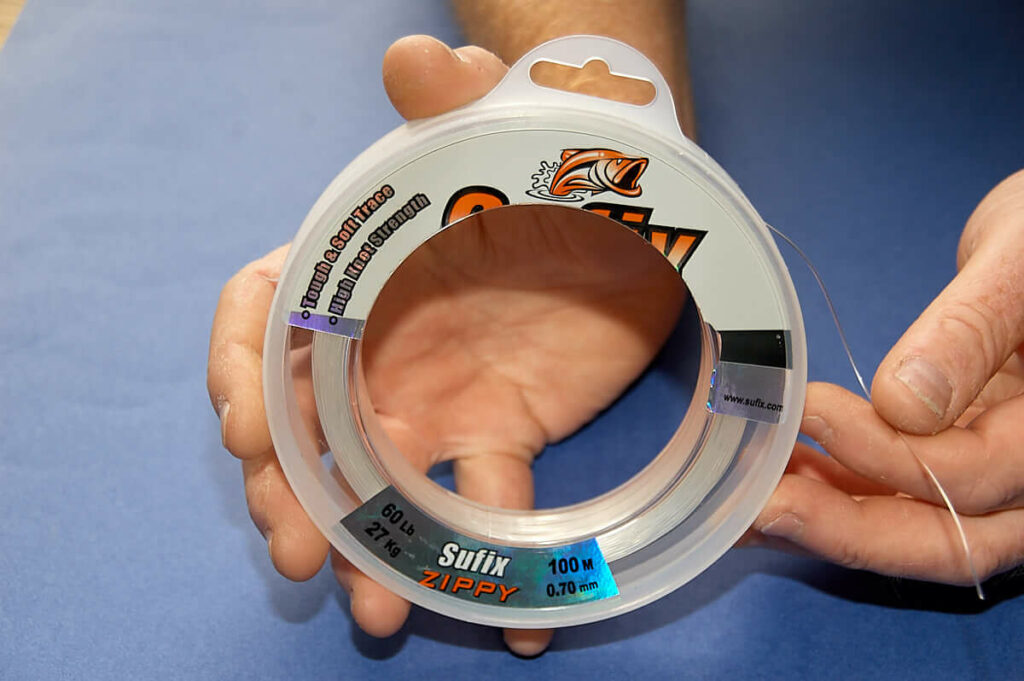
1 - Begin with 60-inches of 60lb clear mono.
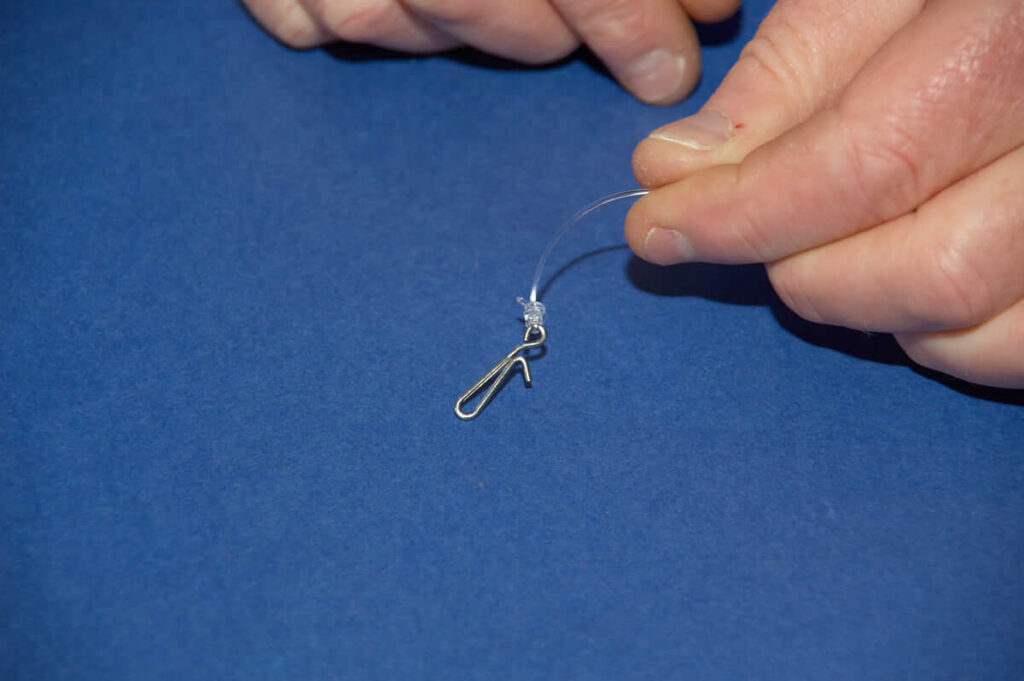
2 - At one end tie on a Gemini Lead bait Clip.
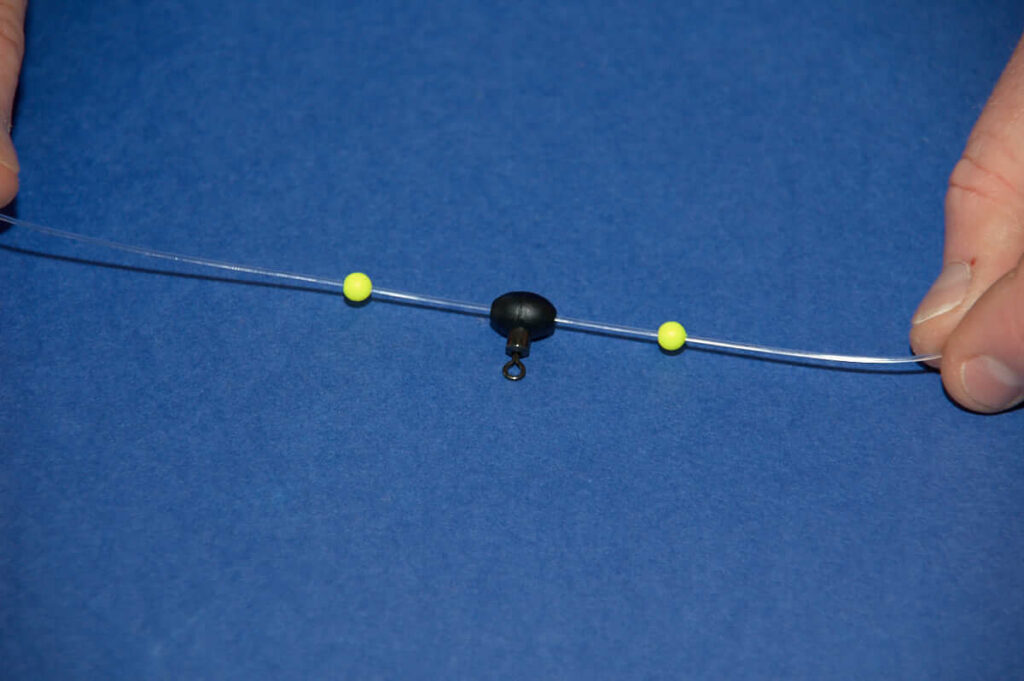
3 - Slide on a 5mm rig bead, a pulley rig bead and another 5mm rig bead. If you prefer you can replace the Pulley Rig Bead with a standard size 4 rolling swivel, but this creates a weakness in the rig body line after repeated casting, that’s why Talk Sea Fishing recommends the Pulley Rig Bead.
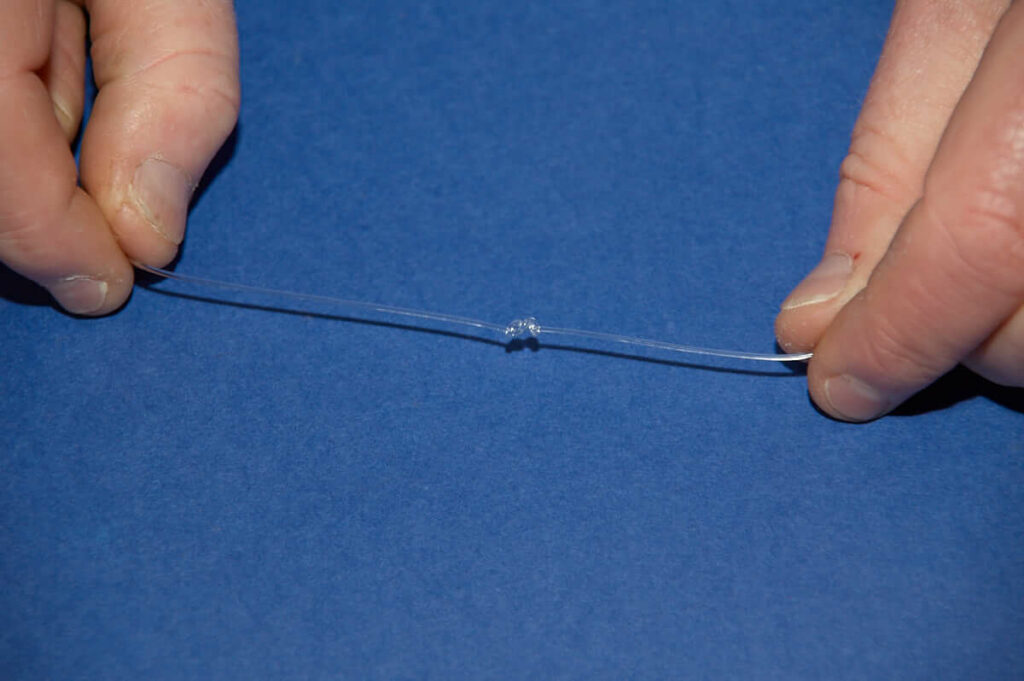
4 - Leaving a good 24-inches of free end to form the hook snood tie in a figure of eight knot. There is no weight when casting on this knot and it is perfectly strong for fighting big fish.
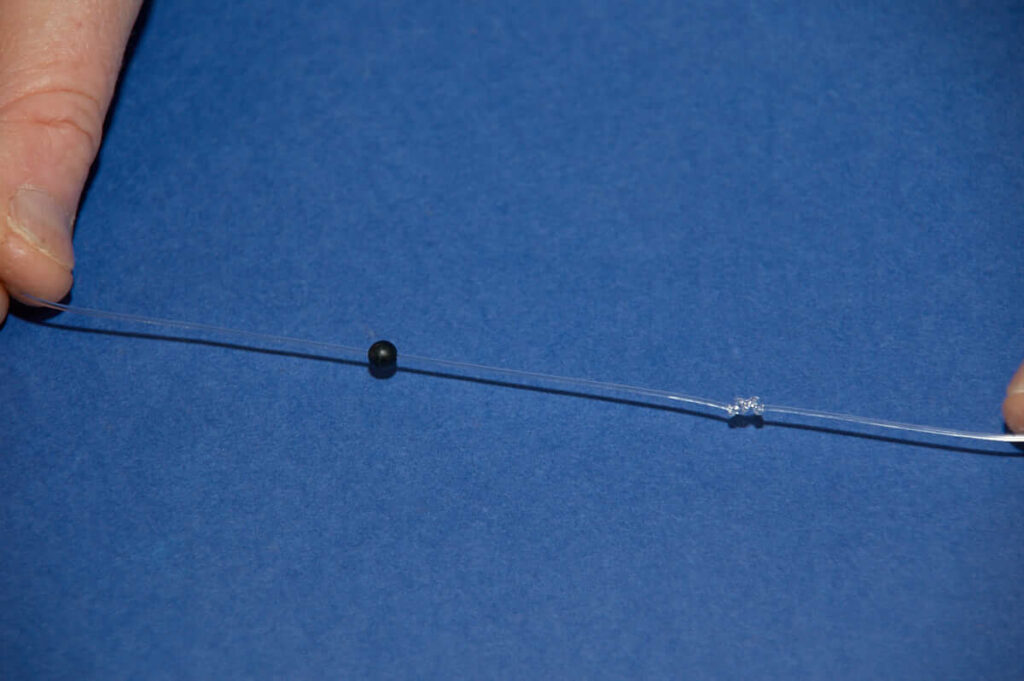
5 - On the free end forming the hook slide on an 8mm rig bead.
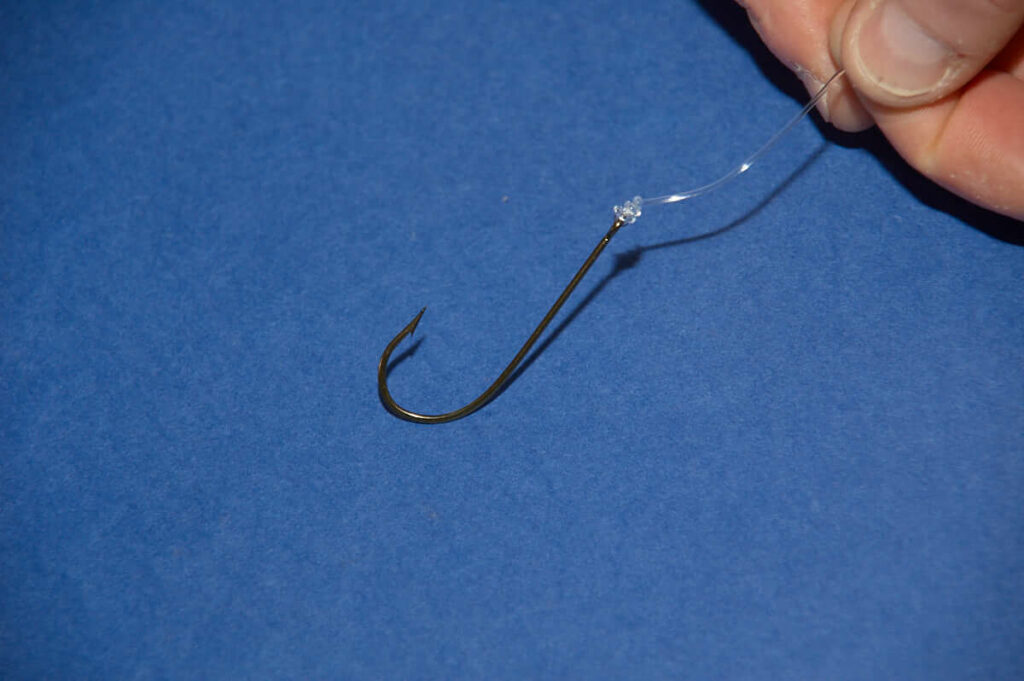
6 - Tie on a Mustad 79515 hook size 3/0.
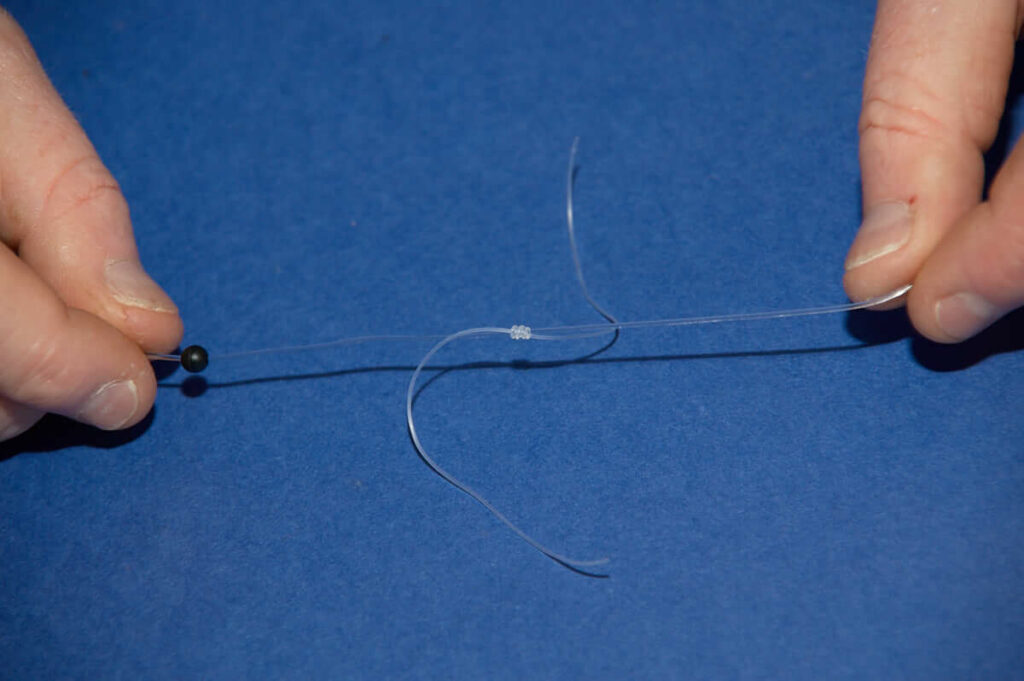
7 - Above the bead positioned above the hook tie on a Powergum sliding stop knot to act as a bait stop.
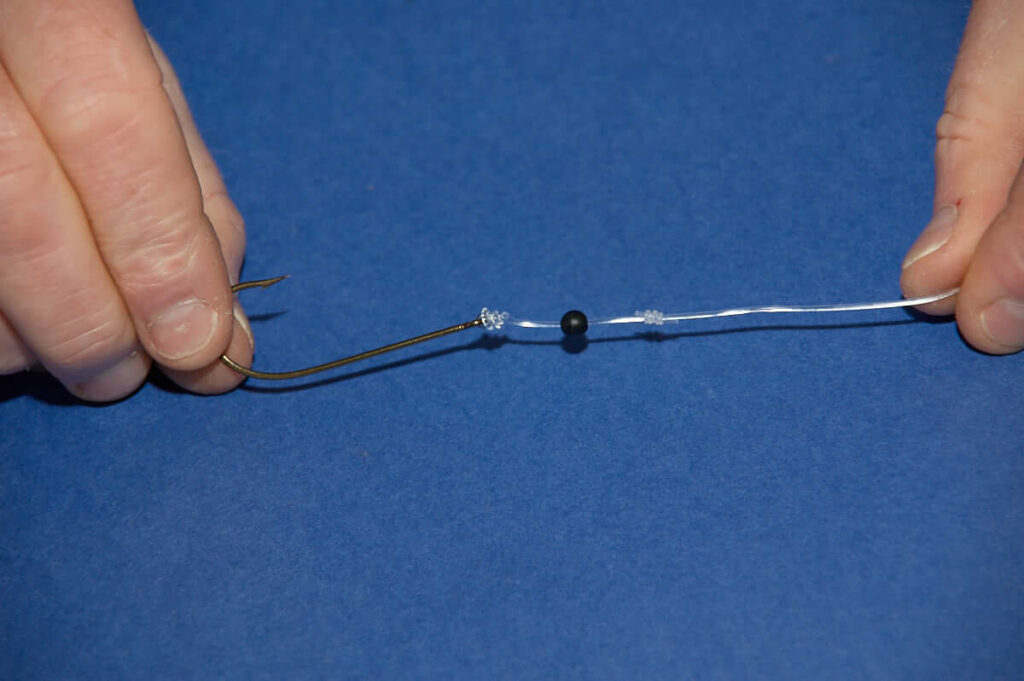
8 - The hook is clipped into the hook of the Lead Bait Clip for casting and will release when the line slackens as the lead hits the water after casting.
Fish the pulley rig with a 5 to 6oz release wire lead. When a fish breaks the lead out, the rig will slide through the Pulley Rig Bead until it reaches the bead above the swivel. This sees the weight lifted up in the water above the fish and away from any potential snags.
The pulley rig can also be classed as a self-hooking rig. As the ray eats the bait then slowly flaps away, the rod tip is pulled down to indicate the bite proper, but also the fish comes up against the lead weight encouraging that self-hooking. All the angler then needs to do is to lift the rod and let the ray swimming away from you tighten the line and pull the rod over to make sure the hook is fully set.
If you’re fishing much deeper water with a steep line angle into the water, then the long and low rig is a better option as it presents the bait on a flowing trace and allows the bait to move naturally in the tidal current. This rig can also be cast a long way, so is an option worth having in your rig wallet.
Long and low rig
1 - Begin with 40-inches of 60lb clear mono line.
2 - At one end tie on a Gemini Lead Bait Clip.
3 - Slide on a rig crimp, a 3mm bead, a size 6 rolling swivel, another bead and a rig crimp. Crimp this in position 1-inch above the Lead Bait Clip.
4 - To the free end of the mono tie on an inverted Gemini Lead Bait Clip.
5 - The hook length needs to be about 70-inches of 30lb clear mono or better still Fluorocarbon. Use 40lb if you’re fishing over snags. Tie this to the bottom swivel eye.
6 - Slide on a rig crimp, a size 5mm bead, then a Mustad 79510 Viking hook size 3/0.
7 - Leaving about an inch to 1.5ins above the hook, crimp the crimp in position to secure the bead and form a bait stop. This stops the bait sliding up the hook trace away from the hook during the release and flight of the cast.
8 - Put the hook trace in the inverted Bait Clip, then the baited hook into the hook of the Lead Bait Clip.
A more concise description of setting up the rig for casting may help the more inexperienced angler here. To prepare the rig for casting, the hook trace is first positioned in the inverted Bait Clip at the top of the trace, then the baited hook is clipped into the Bait Clip at the base of the rig. You’re aiming to get the hook trace just tight enough to be secured and held in place. The best way to do this is to leave the hook swivel, bead and crimp assembly loose while completing the rig. When the rig is complete, put the hook trace inside the top clip and the hook in the bottom bait clip. Now slide the top hook trace crimp into position so that the whole hook trace comes just tight and crimp the top crimp in position, then secure the lower crimp. This tensions the hook trace perfectly!
As the cast is made, when the lead weight hits the water, the baited hook falls free of the rig clip, as does the trace in the inverted rig clip. As the rig falls in the water the trace will flow out and sit fully extended on the seabed. Having the long trace well away from the rig allows the bait to wash around on the seabed to tide and wave movement giving a very natural presentation.
Also, with the long trace, the ray has the room to pick up the bait having approached it from downtide, turn back into the tide flow and increase swimming speed. As the weight of the fish comes up against the grip lead, the rig acts like a bolt rig and will generally self-hook the fish. The long hook trace also gives slower feeders, such as rays, the freedom to fully settle over the bait, then move away, without coming in contact with the tight rig body line.
Another advantage of this design is that when a fish is hooked, the long hook trace positions the fish well below the lead weight, which is lifted up in the water well away from any snags. This reduces the chance of lost fish and lost tackle.
As we so often say, ordinary clear mono is OK for the hook trace, but this is softer in its make up than fluorocarbon so is less abrasion resistant. This won’t necessarily matter if you’re fishing over clean mud and sand, but it does matter if you’re fishing in among broken ground or having to fight fish in over rougher ground. Also, the stiffer nature of the fluorocarbon means you’ll have fewer tangles when fishing in faster tide runs or sea swells.
The top bait for undulates is mackerel, followed by squid and sandeel.
Regards mackerel, cut a fillet off the mackerel, then cut it into sections about 2ins across. Pass the hook point through from the skin side and pull the hook fully through. Now pass the hook point back through the flesh towards the bottom edge of the section leaving just the hook point showing through. Fold the mackerel strip around the hook and secure with wraps of bait elastic. This creates a sort of sausage shape with the juicy flesh on the inside. This allows for a slower release of scent which creates a scent trail for the ray to follow.
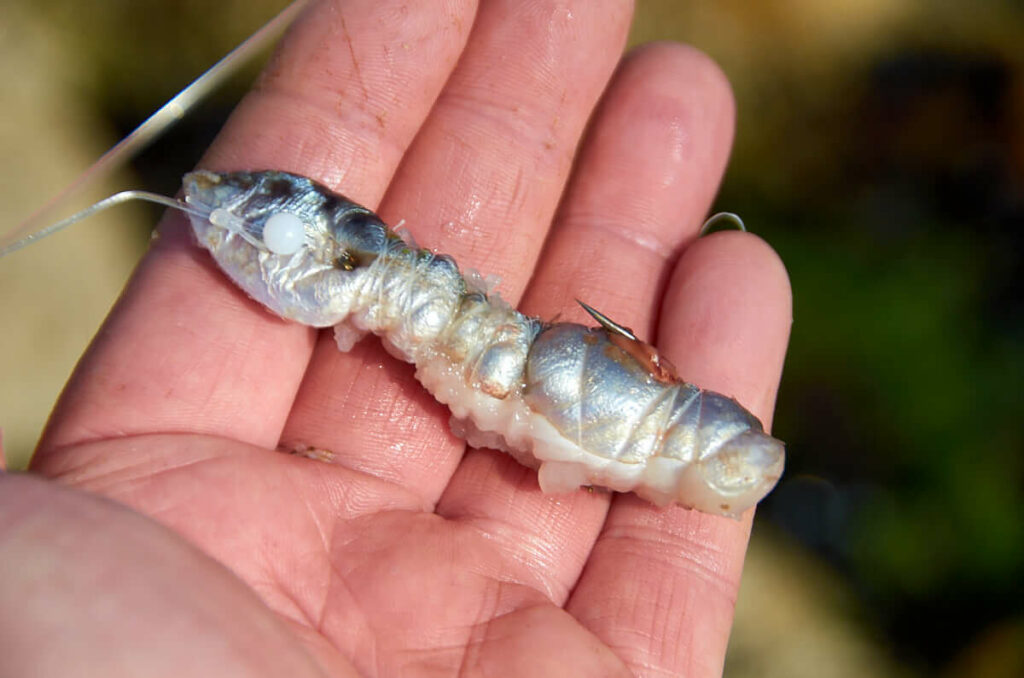
The squid is treated the same but leave the guts inside to increase the scent. It can also pay to tip the squid with a small square of mackerel on the hook point to create a very effective combination bait.
Smaller sandeel should be used whole. Cut the head and tail off. Pass the hook point into the tail cut and then slide and bend the sandeel right down the bend of the hook and back up the hook shank until it lays straight with the hook point sticking out at the bottom. If the sandeel are small you can add a second sandeel alongside the first, then secure it with bait elastic. This creates a bulkier bait, but again one that is oozing juices.
A bait that proves highly effective for the bigger undulates is a pouting fillet. It’s the smaller sub 5-inch fish that are ideal. Remove the fillet, then cut the fillet in half. Pass the hook fully through from the skin side and then bring the hook point out at the bottom. Put the second section of the fillet flesh side up against the first fillet. Now fold the sections round the hook and again wrap securely with bait elastic. This is brilliant bait at any time, but especially so in the autumnal period.
Shore anglers may also catch undulates when fishing smaller lugworm or ragworm baits, but these tend to be the smaller fish. They will also take peeler crab or soft crab baits occasionally.
A very effective technique when targeting undulates in any situation is to use two preferably identical rods side by side. You can then fish one at maximum casting range and one dropped shorter. Each subsequent longer cast can then be shortened and the close in rod lengthened until you find the fish and the range at which they are settled in. This method also enables you to locate depressions or deeper channels that the rays will sit in or travel through.
Another advantage of the two rod approach is that you can fish two different baits and decipher which bait, on the day, is best. Simple tactics like this can make a major difference to your catch results.
Another tactic to try is to swap the grip lead for a plain lead. Cast to long range, then let the tide pressure on the line drift the lead and bait around in a downtide direction. This is another way to find depressions, channels and other spots where the rays may be working through or holding up.
These rays like a fresh bait, not a stale bait, so you’ll catch more fish if you leave a bait fishing no longer than 15 to 20-minutes then change to a fresh one. This sees the maximum scent trail achieved and the bait still fishing effectively. Less juicy bait such as sandeel, leave it no longer than 15-minutes, especially if the tide is running strongly.
Undulates give a typical ray bite. You’ll see the rod tip shudder or slightly dip a couple of times. This is the ray settling on the bait and the wing edges touching the line. Don’t react to this at all. Wait until the rod tip pulls right over then lift into the fish to set the hook. If you see the tip nod a few times then nothing happens, after a couple of minutes it is best to tighten up and pull the weight free. Sometimes a ray will take the bait and sit on it. If you leave it too long, they can be deeply hooked, so it’s best to check and recast with a fresh bait.
Undulates can fight quite well and make short but solid runs taking a few yards of line. They will also kite parallel to the shore when they feel the water shallowing. Just keep a steady pressure on, let big fish have line if they want it, and slowly pump them in. Try and use a wave table to surf the fish in safely.
[*]It does seem as though undulates form small groups of up to a dozen fish, and they will move through an area together. It can pay to have ready baited rigs hung from your rod rest. Then, when you catch a ray, reel it in and instantly unclip the trace, clip on a fresh trace and bait and recast. Not deal with the fish which will be fine in that short span of time. This maximises your fishing time and again can really increase your catch ratio.[*]If you’re fishing an obvious deeper channel that the fish use for travelling, try to find one venue that gives access to this early in the tide period, and when bites slow, have another in mind further up the channel you can divert to, to ambush the fish again further up as they move with the tide. Sticking in one place when targeting undulates will often see a short flurry of bites then nothing. The fish have moved on and you need to do the same to continue catching.[*]Sometimes, undulates are reluctant to try and take baits that are moving in fast water. In this instance, try shortening the hook trace down to 18-inches or less. This simple rig change sees the bait less likely to move much off the seabed keeping it in the feeding zone of the rays.[/list]
Typical undulate holding ground offshore are shallow sandy sandbanks, but also gutters that run among generally flattish ground. Often, the bigger fish will be found on the clean patches among broken rough ground.
If you’re fishing tight inshore inside sheltered inlets and bays, look for the small headlands that force a tidal current to angle off from the geographical line of the land. They will sit just on the inside edge of this, especially if the tide has created a slight rising angle towards shallower ground just inside the headland.
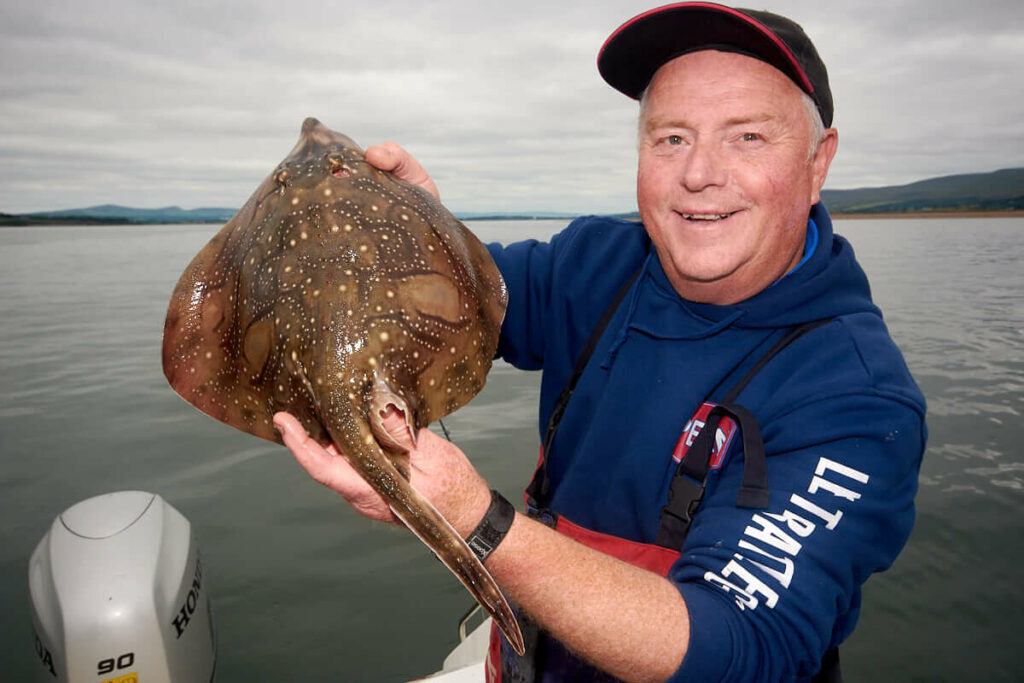
Offshore undulate rays respond to tides much like they do when inshore. They will be more active on the bigger spring tides, and travel more to feed within their chosen locality, especially the tides climbing up to the biggest tides of that series. Once the tides start to diminish, then so to, does their activity level.
During neap tides though, especially in areas where tides are very fast, the undulates can feed well during the neap tides too.
They feed best when the tide is flowing with periods of slack water seeing little or no feeding done. They also seem to work an area of ground on the flood and middle ebb, then go to ground to await the next new flood tide.
In deeper water weather patterns are not quite as important as they are when shore fishing. But still, periods of more settled seas will fish best. If you intend to target undulates, then try to avoid the days after a good blow or storm has gone through. They are not lovers of coloured seas, or seas with big swells when close inshore.
Much depends on the depth you’re fishing, but they are less inclined to feed when the light levels entering the sea are high, such as bright clear skies and sunny weather. They feed best under cloudy skies and with the sea carrying a slight ripple from a breeze that reduces light levels.
Two outfits will cover all undulate ray fishing from the boat. A more sporting rod and reel is a 12lb rod and a reel holding about 300yds of 20lb braid. Add a shock leader of 20lb fluorocarbon about twice the length of the rod. This gives the main line some protection from abrasion and gives the line a slight stretch when you’re playing a big fish up through the water column. This lighter tackle is ideal for inshore grounds in water up to 30-feet with a light tide run and where leads under 8ozs can be used.
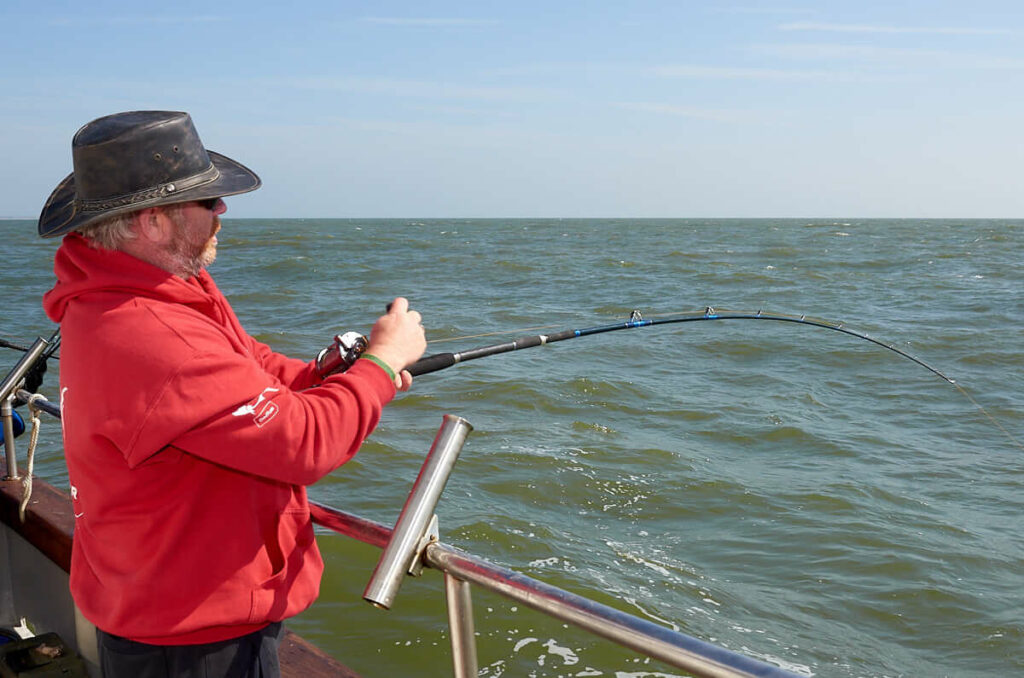
The second rod and reel is a 12/20lb or straight 20lb line class rod. The extra power in these blanks is better able to handle heavier leads up to 12ozs, or more, and has the backbone to lift a big fish up from the depths in a fast tide run. The reel needs to take 300yds of 30lb braid with some mono backing. Again, add a 30lb shock leader twice the length of the rod to give that abrasion protection and a hint of stretch.
Carry a range of leads from 4ozs up to 1lb, but in most undulate holding areas leads between 4ozs and 10ozs are more than adequate, even in the faster tide runs.
One rig covers almost all undulate fishing from the boat. It’s a simple but very effective flowing trace that allows the bait to move naturally over the seabed and, more importantly, keeps the bait tight to the seabed where the undulates feed.
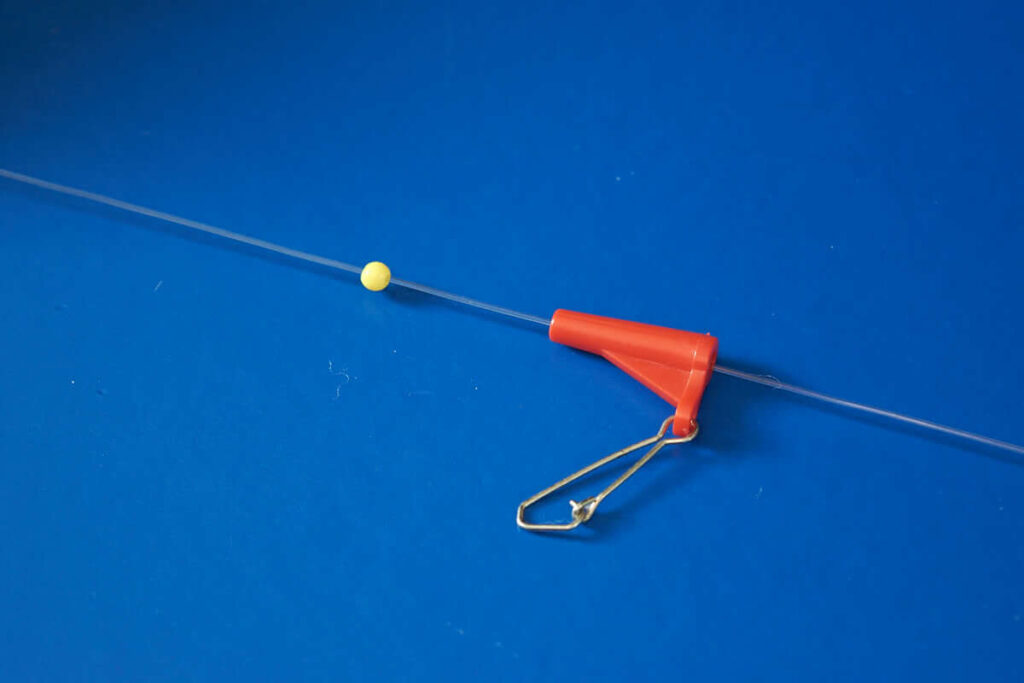
1 - Onto the shock leader, slide on a Zip Slider Boom followed by a size 5mm plastic bead.
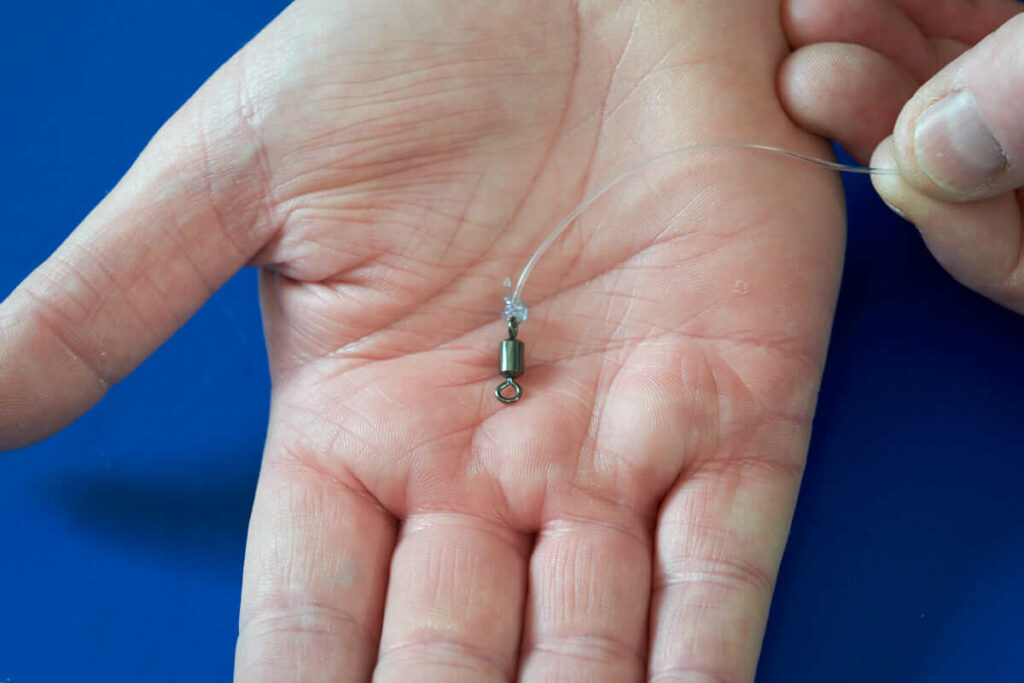
2 - To the free end of the shock leader, tie on a size 2 rolling swivel.
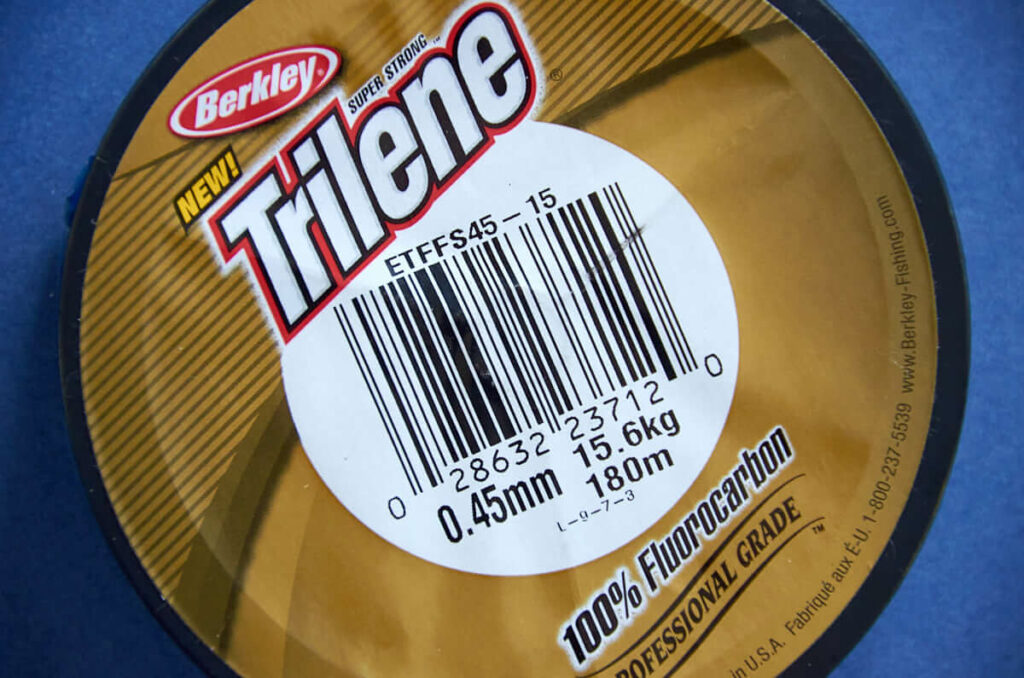
3 - To the free eye of the rolling swivel, tie on 30-inches of 30 to 40lb fluorocarbon. 30lb is okay for general fishing, but for bigger fish and when fishing over rough ground increase to 40lbs.
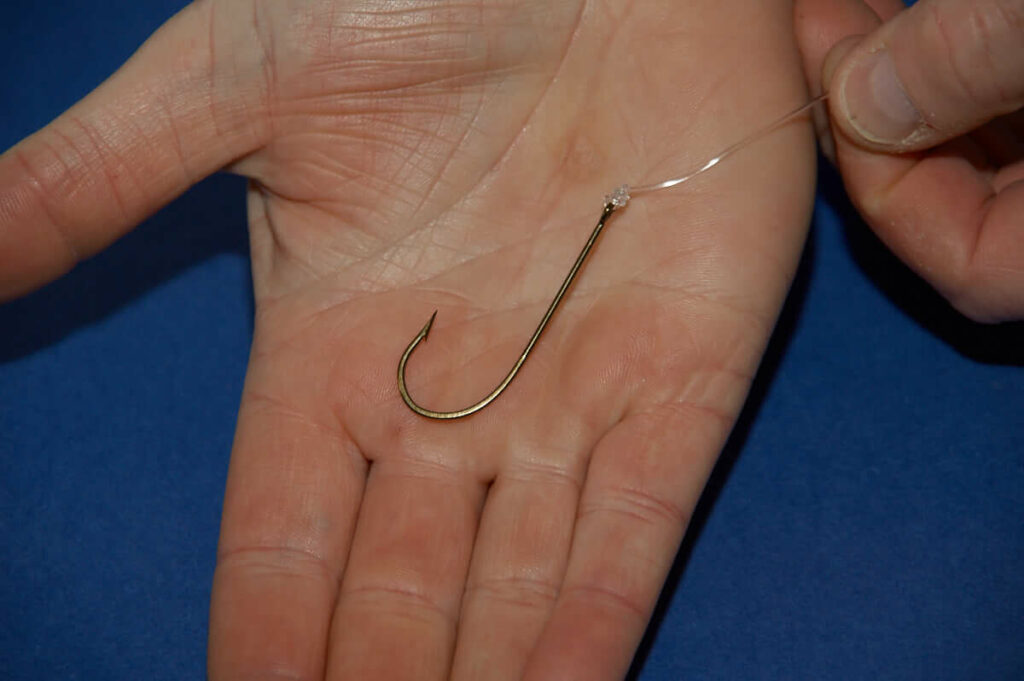
4 - To the end of the Fluorocarbon tie on a size 3/0 to 4/0 Mustad Viking 79515 Viking pattern hook.
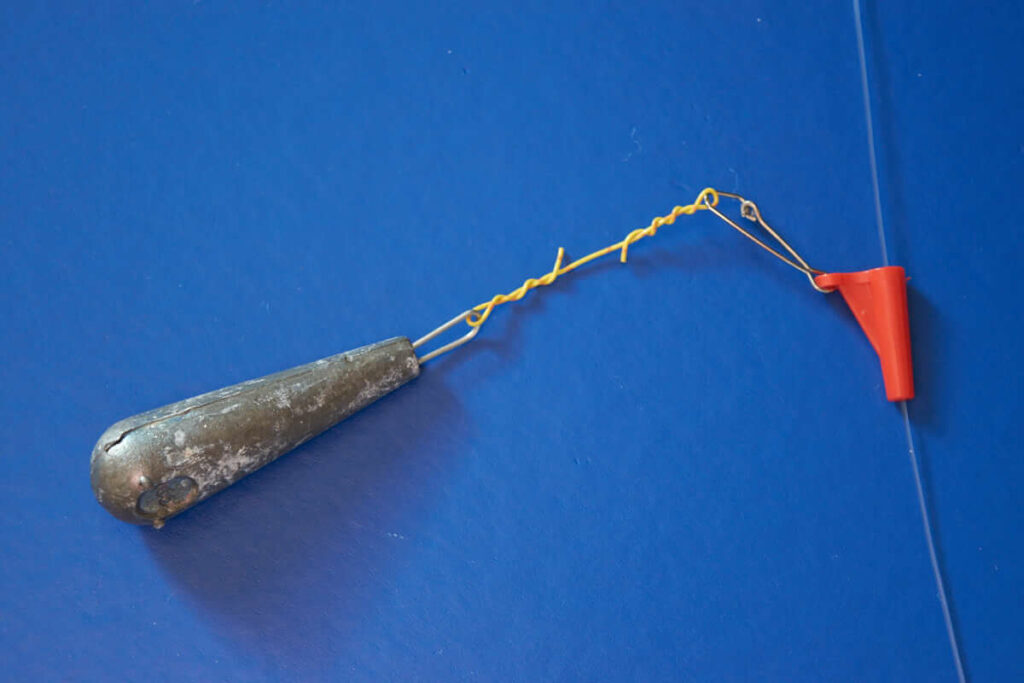
5 - The lead weight attaches to the lead clip on the Zip Slider Boom.
Although a simple rig it offers several advantages. Being a sliding ledger, it means that when the fish takes the bait and moves away, there is direct contact through the line to the rod tip, so bite detection is excellent. The long flowing trace imitates how a natural bait washing around with the tide behaves, plus, when fishing over rough ground patches, when a fish is hooked the lead weight lifts up above the fish and is well away from the snags.
Baits stay the same offshore, though mackerel will dominate even more. You can bait up with simple 2in wide sections taken from the fillet of a mackerel when anchoring. Sandeel, squid and again pouting fillets work well.
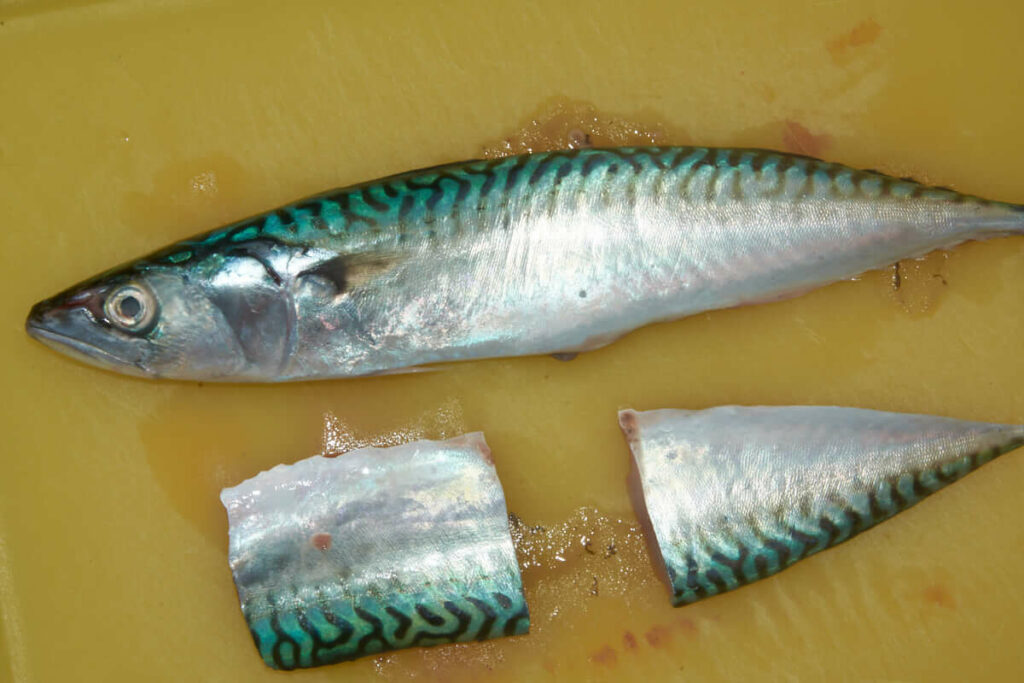
However, when drift fishing, it’s better to take the full fillet off the flank of the mackerel, then cut lengthways long belly strips from the white belly of the mackerel. Cut these in half and you have the perfect sized offshore undulate bait. Pass the hook point through one end only with the thinnest end of the bait free to flutter freely. This increases movement and presents a bait very naturally as the bait is pulled along on the drift.
Fishing at anchor
Where possible, the best undulate ray action when boat fishing will be at anchor. Positioning the boat uptide of a known holding spot will maximise your chances. This type of fishing often exists very close inshore. The idea is to anchor well uptide then let anchor rope out to get the boat positioned perfectly above the holding area then trot baits back either into a gully, a depression, or a series of sand banks.
It’s important to work out just how much lead is needed to just hold bottom, but then when you lift the rod tip the weight can be dropped back a few feet so you can keep trotting the bait back from the boat a short distance each time until you contact the fish. This technique also keeps a tight line. If you have a too heavy lead and try to lift it and release line, the lead weight will pretty much stay where it is, but you’ll get a big downtide bow in the line which kills bite detection.
Bites are simple dips or nods of the rod tip. Ignore this! Only when the rod tip really pulls over do you know that the fish is committed and probably already hooked. Just lift into the fish by tightening the line until you feel the weight of the fish.
Small rays will feel like they are circling or twisting in the water column, but a bigger fish will try to hold on the seabed and when it does lift it will kite side to side and make short but powerful runs taking a few yards of line. Steady pressure will soon subdue the ray.
Fishing on the drift
Drift fishing means you cover more ground, but it can be hit-and-miss for undulates for two reasons. Firstly, they are not fast movers and prefer to pounce on easy prey. They are less likely to see a passing bait and chase it down unless it can be easily caught. Secondly, the undulates are often closely packed on specific ground. This means that when specifically targeting undulates you can waste a lot of time fishing ground carrying other species but possibly no undulates. When you do hit undulates you may see one or two fish caught, but then you’re past the holding ground.
The technique for targeting undulates on the drift is a bit more hands on. Obviously, you need to hold the rod all the time to feel for bites. Choose a lead weight that is heavy enough to keep in constant contact with the seabed. You need to feel the lead dragging bottom all the time. Every 30 seconds, flick the reel into free spool and allow, using slight pressure from your thumb, to let line off, say about 10ft, in faster tides 20ft, then re-engage the reel and let the line retighten to make the bait move again. This series of pauses with the bait suddenly static on the ground gives any interested rays time to catch up with and pounce on the bait. Remember to do this as undulates won’t trace a drifting bait as willingly as say thornbacks, small-eyed or spotted ray will.
Bites will feel like a sudden increasing pressure on the rod tip. As before, do nothing until the rod tip pulls over to the weight of the fish which will set the hook.
[*]If you’re fishing at anchor and the tide flow is minimal, try lifting the rod tip up and down just enough to lift the weight off the seabed a couple of feet, then drop it back. This will also induce an upward lift of the bait which will then drop back as this movement can often trigger a bite when conditions are difficult and bites few and far between.[*]A good way to bait with squid when drift fishing is to use a small section of mackerel on the hook shank, then add a strip of white squid about 3-inches long to the hook point. This has both smell and lots of movement. You can also increase the whiteness of the squid by scraping the slimy skin off the flesh before you bait up.[*]Make sure your hooks are truly sharp. Undulates do seem to throw hooks more than most rays, so a sharp hook has a much better chance of finding a secure hold in their tough jaw. Don’t overdo the sharpening and over thin the hook point. Just make sure the hook point will catch in your nail when it’s dragged over it. If it gets a grip in the nail, it’s sharp enough![/list]
About undulate ray
Arguably, the undulate is the most distinctive and prettiest ray the angler can catch. The highly distinctive patterning and markings evident on its back has seen it acquire the nick-name “the pop art ray” as the coloured patterning looks very much like modern art.
Due to this rays localised distribution and late maturity and therefore being vulnerable to commercial overfishing, its numbers have been much reduced over the past three decades, some say by 80%, and since 2009 it has been illegal to retain undulates, and they must be returned alive to the water. There are though signs that their numbers are gradually increasing.
The Irish Specimen Fish Committee, a superb organisation that sets the specimen weights for Irish angling removed the undulate for some time from its specimen awards list but has since reinstated this ray on a measured length only scale allowing specimens to be claimed but the ray returned alive immediately after capture.
A rarely seen fact about the undulate is that it is not really a ray. The undulate has fins on the tail indicative of skate species, whereas true rays have whip-like tails with no fins.
How to identify an undulate ray
As already suggested, this is a very distinctive ray and frankly, it’s almost impossible to confuse this ray with any other.
The wing edges at their peak are rounded. The back is covered in prickles though these are absent on the rear edges of the pectoral and pelvic fins. The snout is short, has prickles on it, and tends to look slightly transparent. The jaws are armed with crushing plates comprising three different types of teeth, wedged, pointed and chisel-shaped designed to crush and chew through different types of hard material including hard crustacean shells and fish flesh. The underside of this ray is smooth. Smaller undulates have a continuous row of spines down the backbone, whereas in adult fish this is interrupted, plus they have irregular rows of spines evident down the sides of the tail. The dorsal fins at the end of the tail are widely separated and can have spines in between, and as previously mentioned identify this as a true skate, though it is always referred to as the undulate ray.

The back of this ray is usually a yellowish brown to mid brown with darker blotches, sometimes the back is overall darker brown if living in among mud patches and broken rough ground. Look for the distinctive wavy dark banding edged with white or yellowish spots that covers both wings. The belly is white, sometimes tinged with grey.
Little is really known about undulate ray’s habits, but they produce young that are inside protective egg capsules measuring up to 2ins including the horns and are an opaque reddish brown. The eggs are probably deposited in weed beds and on rough structure via the tendrils. This occurs in late summer in the UK, but in spring in the warmer waters of the Mediterranean.
It is thought that undulate rays can live up to twenty years old and achieve weights exceeding 25lbs, though this is rare. Males are mature at around seven years old, but females don’t reach maturity until nine years. They can lay up 90 eggs over a protracted period with the young hatching within three months, and they leave the egg sacs as perfectly formed, free swimming, tiny rays.
Undulate ray distribution
Undulates are found from North Africa, inside the western portion of the Mediterranean, and up the European coast as far as Holland.
In the UK they are found throughout the English Channel, and in the last decade, their numbers have increased along the Sussex and Kent coast showing as far as the North Foreland. They are caught off the Hampshire coast, also off Dorset, Devon and Cornwall. The textbooks tell us they are found in the southern Irish Sea too, but they are rare here. Wales has no official record for a boat or shore caught undulates on its record list.
In Ireland, again they are confined to southern shores, mainly west Cork but especially the Tralee Bay area of Kerry.
The main thing to remember regard’s undulate rays is that they are very localised in their distribution. They exist in small pockets and are often non-existent just a few miles away. This again makes them very vulnerable to overfishing. Treat them as a localised coastal fish and you won’t go far wrong.
Undulate ray habitat
This ray can tolerate almost estuarine conditions and indeed, is often found in sea areas adjacent to estuary environments where freshwater is lightly mixed with saltwater, an example being Fenit harbour inside Tralee Bay, Kerry and the Hampshire coast.
They are lovers of sand, but more so mud or a mix of the two and favour depressions in the mud and sand where they can sit with the tide flowing over the top of them. They can also be found in broken ground where there is a mix of mud, sand and rougher patches. They also like to lay up just off the edge of the tide close to hard rock and man-made structure, but with a clean seabed.
Undulates can also be found in areas where fine shingle sits among mud or sand, especially so if the shingle has formed an inclined bank as they like to sit on this facing into the tide and pick off small fish that are pushed towards them by the flowing tide.
Inshore they are found in depths as little as a few feet, though this is not too common. Offshore their liking is for a depth of around 20-metres, but they are found as deep as 200 metres.
Undulate ray diet
A true predator that is adept at ambushing passing prey smothering it with their wings then shuffling over the capture to position it in the mouth.
They are really only fish eaters taking typically small pouting, poor cod, whiting, gobies, sandeel, and squid as there is some indication, they will swim up off the bottom some distance to intercept a shoaling food source.
They also take crustaceans, especially crabs when working tight in along the shoreline where rocks and weed dominate the low water line with access to sand or mud close in.
Undulate ray season
Undulates will sometimes surprise and individual fish can turn up either side of Christmas during mild winters. Traditionally though, April is the start of the main season when fish start to move back tight inshore and their numbers increase quickly. May and June can be excellent months, July and August can see a slight reduction in catches, maybe because the fish spread out slightly more, but September, October and early November can again see some major catches, especially of the bigger fish over 8lbs.
Tides
As we’ve established, undulates do not move out of their preferred locality, but they do move in and out with the tides, especially along the deeper beaches and inside larger bays and inlets. Their movement is less on the smaller neap tides when they tend to stick to the deeper areas close to shore or seek out areas where the tide run is flowing that bit quicker, such as an area where a bottleneck occurs or where a deeper channel carries the main tide run.
During bigger spring tides, they will travel much further and have a habit of working tight into rocky shores but will also favour deeper channels that cut into bays and inlets. They use the channels in the early flood to travel, then spread out into shallow water as the depth increases with the flooding tide. They don’t hang around though, when the tide starts to ease towards high water. This triggers them to quickly move back out into the deeper channels where they will slowly drop back as the ebbing tide retreats. They also like any deeper depressions in the seabed and will sit in these when not actively feeding. If you can locate these and cast into it, then you can continue to catch as the fish can be concentrated in numbers.
When fishing shallower areas, be prepared to keep one rod out in any deeper channels. Not only do the rays use these as transit routes, but some will often stay in these and feed working gradually in with the flowing tide, then back out again.
The best periods of the tide then, are the hours from 1.5 hours after low to 1.5 hours before high, and the middle three hours of the ebbing tide. Generally, low and high water slack when there is little if any tide run then bites slow right down.
Weather patterns
On the more exposed open coast beaches undulates are lovers of semi settled conditions. Periods of light to moderate onshore winds are good, even light offshore winds can fish well, but periods of rougher seas will see the bulk of the fish move off into less turbulent water.
In more sheltered areas, where sea conditions are not affected too much by strong winds, then the fishing can remain good, but what they don’t like is water full of sediment for long periods. This tends to push them off to deeper waters with the seabed depressions often their home until conditions improve.
This is another fish that when entering shallower water, it prefers days with overcast cloud and subdued light levels. These are the days when they will work quite close to a rocky weedy shore. They can be caught on days with bright sunshine, but in shallow water catches will be less. Light levels and bright sunshine are less of an issue when fishing beaches with a decent depth of water, tight in, say 15ft or more.
The best time for catching undulates is dusk and dawn. They seem more active in these low light level periods. They can also be caught in the dark, too.
Shore fishing for undulate ray
Tackle
Casting distance and tide run will normally demand a standard beachcaster rated 4-6ozs and between 12ft and 13ft long. Suitable reels are typically the Penn525 Mag series as this reel has the distance ability, but also the line capacity to up the line breaking strain to 22lbs if you’re fishing among broken ground. On beaches with little in the way of snags, then stick to the same reel but load with 18lb line, when greater distance is needed an Abu 6500 reel, Penn Mag4 or an Akios, Shimano or Daiwa equivalent loaded with 15 to 18lb line can gain those extra yards. A 60lb shock leader completes the outfit.
If you’re a fixed spool user, then the European 14ft rods matched to a 7000 or 7500 reel, such as the Penn Spinfisher or Affinity will get you maximum casting range for the minimum effort. Load the reel with 30lb braid and add either a tapered shock leader or, better still, an 80lb braid leader connected to the 30lb by back to back grinner knots.

Most rays, and the undulate is no exception, want their meals as easy as they can get them. This means the use of release grip wire leads that anchor the bait in one place. The ray will then swim up the bait's scent lane until it finds the bait.
For most undulate fishing a size 3/0 long shank Aberdeen or a Mustad Viking 79515 3/0 works well for all baits. They do not have big mouths and baits should be kept sensible to allow easy intake for them. Even for the bigger 10lb plus specimen sized undulates need no more than a 4/0. Some very successful undulate ray anglers prefer a smaller size 2/0 feeling the smaller baits are more easily taken in.
Shore fishing rigs for undulate ray
Pulley rig
The best rig for all ground feature, be it totally clean, but especially when you’re fishing over broken ground or need to bring fish back over rougher ground close in, is the Pulley rig.

1 - Begin with 60-inches of 60lb clear mono.

2 - At one end tie on a Gemini Lead bait Clip.

3 - Slide on a 5mm rig bead, a pulley rig bead and another 5mm rig bead. If you prefer you can replace the Pulley Rig Bead with a standard size 4 rolling swivel, but this creates a weakness in the rig body line after repeated casting, that’s why Talk Sea Fishing recommends the Pulley Rig Bead.

4 - Leaving a good 24-inches of free end to form the hook snood tie in a figure of eight knot. There is no weight when casting on this knot and it is perfectly strong for fighting big fish.

5 - On the free end forming the hook slide on an 8mm rig bead.

6 - Tie on a Mustad 79515 hook size 3/0.

7 - Above the bead positioned above the hook tie on a Powergum sliding stop knot to act as a bait stop.

8 - The hook is clipped into the hook of the Lead Bait Clip for casting and will release when the line slackens as the lead hits the water after casting.
Fish the pulley rig with a 5 to 6oz release wire lead. When a fish breaks the lead out, the rig will slide through the Pulley Rig Bead until it reaches the bead above the swivel. This sees the weight lifted up in the water above the fish and away from any potential snags.
The pulley rig can also be classed as a self-hooking rig. As the ray eats the bait then slowly flaps away, the rod tip is pulled down to indicate the bite proper, but also the fish comes up against the lead weight encouraging that self-hooking. All the angler then needs to do is to lift the rod and let the ray swimming away from you tighten the line and pull the rod over to make sure the hook is fully set.
If you’re fishing much deeper water with a steep line angle into the water, then the long and low rig is a better option as it presents the bait on a flowing trace and allows the bait to move naturally in the tidal current. This rig can also be cast a long way, so is an option worth having in your rig wallet.
Long and low rig
1 - Begin with 40-inches of 60lb clear mono line.
2 - At one end tie on a Gemini Lead Bait Clip.
3 - Slide on a rig crimp, a 3mm bead, a size 6 rolling swivel, another bead and a rig crimp. Crimp this in position 1-inch above the Lead Bait Clip.
4 - To the free end of the mono tie on an inverted Gemini Lead Bait Clip.
5 - The hook length needs to be about 70-inches of 30lb clear mono or better still Fluorocarbon. Use 40lb if you’re fishing over snags. Tie this to the bottom swivel eye.
6 - Slide on a rig crimp, a size 5mm bead, then a Mustad 79510 Viking hook size 3/0.
7 - Leaving about an inch to 1.5ins above the hook, crimp the crimp in position to secure the bead and form a bait stop. This stops the bait sliding up the hook trace away from the hook during the release and flight of the cast.
8 - Put the hook trace in the inverted Bait Clip, then the baited hook into the hook of the Lead Bait Clip.
A more concise description of setting up the rig for casting may help the more inexperienced angler here. To prepare the rig for casting, the hook trace is first positioned in the inverted Bait Clip at the top of the trace, then the baited hook is clipped into the Bait Clip at the base of the rig. You’re aiming to get the hook trace just tight enough to be secured and held in place. The best way to do this is to leave the hook swivel, bead and crimp assembly loose while completing the rig. When the rig is complete, put the hook trace inside the top clip and the hook in the bottom bait clip. Now slide the top hook trace crimp into position so that the whole hook trace comes just tight and crimp the top crimp in position, then secure the lower crimp. This tensions the hook trace perfectly!
As the cast is made, when the lead weight hits the water, the baited hook falls free of the rig clip, as does the trace in the inverted rig clip. As the rig falls in the water the trace will flow out and sit fully extended on the seabed. Having the long trace well away from the rig allows the bait to wash around on the seabed to tide and wave movement giving a very natural presentation.
Also, with the long trace, the ray has the room to pick up the bait having approached it from downtide, turn back into the tide flow and increase swimming speed. As the weight of the fish comes up against the grip lead, the rig acts like a bolt rig and will generally self-hook the fish. The long hook trace also gives slower feeders, such as rays, the freedom to fully settle over the bait, then move away, without coming in contact with the tight rig body line.
Another advantage of this design is that when a fish is hooked, the long hook trace positions the fish well below the lead weight, which is lifted up in the water well away from any snags. This reduces the chance of lost fish and lost tackle.
As we so often say, ordinary clear mono is OK for the hook trace, but this is softer in its make up than fluorocarbon so is less abrasion resistant. This won’t necessarily matter if you’re fishing over clean mud and sand, but it does matter if you’re fishing in among broken ground or having to fight fish in over rougher ground. Also, the stiffer nature of the fluorocarbon means you’ll have fewer tangles when fishing in faster tide runs or sea swells.
Shore fishing baits for undulate ray
The top bait for undulates is mackerel, followed by squid and sandeel.
Regards mackerel, cut a fillet off the mackerel, then cut it into sections about 2ins across. Pass the hook point through from the skin side and pull the hook fully through. Now pass the hook point back through the flesh towards the bottom edge of the section leaving just the hook point showing through. Fold the mackerel strip around the hook and secure with wraps of bait elastic. This creates a sort of sausage shape with the juicy flesh on the inside. This allows for a slower release of scent which creates a scent trail for the ray to follow.

The squid is treated the same but leave the guts inside to increase the scent. It can also pay to tip the squid with a small square of mackerel on the hook point to create a very effective combination bait.
Smaller sandeel should be used whole. Cut the head and tail off. Pass the hook point into the tail cut and then slide and bend the sandeel right down the bend of the hook and back up the hook shank until it lays straight with the hook point sticking out at the bottom. If the sandeel are small you can add a second sandeel alongside the first, then secure it with bait elastic. This creates a bulkier bait, but again one that is oozing juices.
A bait that proves highly effective for the bigger undulates is a pouting fillet. It’s the smaller sub 5-inch fish that are ideal. Remove the fillet, then cut the fillet in half. Pass the hook fully through from the skin side and then bring the hook point out at the bottom. Put the second section of the fillet flesh side up against the first fillet. Now fold the sections round the hook and again wrap securely with bait elastic. This is brilliant bait at any time, but especially so in the autumnal period.
Shore anglers may also catch undulates when fishing smaller lugworm or ragworm baits, but these tend to be the smaller fish. They will also take peeler crab or soft crab baits occasionally.
Shore fishing techniques
A very effective technique when targeting undulates in any situation is to use two preferably identical rods side by side. You can then fish one at maximum casting range and one dropped shorter. Each subsequent longer cast can then be shortened and the close in rod lengthened until you find the fish and the range at which they are settled in. This method also enables you to locate depressions or deeper channels that the rays will sit in or travel through.
Another advantage of the two rod approach is that you can fish two different baits and decipher which bait, on the day, is best. Simple tactics like this can make a major difference to your catch results.
Another tactic to try is to swap the grip lead for a plain lead. Cast to long range, then let the tide pressure on the line drift the lead and bait around in a downtide direction. This is another way to find depressions, channels and other spots where the rays may be working through or holding up.
These rays like a fresh bait, not a stale bait, so you’ll catch more fish if you leave a bait fishing no longer than 15 to 20-minutes then change to a fresh one. This sees the maximum scent trail achieved and the bait still fishing effectively. Less juicy bait such as sandeel, leave it no longer than 15-minutes, especially if the tide is running strongly.
Undulates give a typical ray bite. You’ll see the rod tip shudder or slightly dip a couple of times. This is the ray settling on the bait and the wing edges touching the line. Don’t react to this at all. Wait until the rod tip pulls right over then lift into the fish to set the hook. If you see the tip nod a few times then nothing happens, after a couple of minutes it is best to tighten up and pull the weight free. Sometimes a ray will take the bait and sit on it. If you leave it too long, they can be deeply hooked, so it’s best to check and recast with a fresh bait.
Undulates can fight quite well and make short but solid runs taking a few yards of line. They will also kite parallel to the shore when they feel the water shallowing. Just keep a steady pressure on, let big fish have line if they want it, and slowly pump them in. Try and use a wave table to surf the fish in safely.
Top tips for shore fishing for undulate ray
[*]It does seem as though undulates form small groups of up to a dozen fish, and they will move through an area together. It can pay to have ready baited rigs hung from your rod rest. Then, when you catch a ray, reel it in and instantly unclip the trace, clip on a fresh trace and bait and recast. Not deal with the fish which will be fine in that short span of time. This maximises your fishing time and again can really increase your catch ratio.[*]If you’re fishing an obvious deeper channel that the fish use for travelling, try to find one venue that gives access to this early in the tide period, and when bites slow, have another in mind further up the channel you can divert to, to ambush the fish again further up as they move with the tide. Sticking in one place when targeting undulates will often see a short flurry of bites then nothing. The fish have moved on and you need to do the same to continue catching.[*]Sometimes, undulates are reluctant to try and take baits that are moving in fast water. In this instance, try shortening the hook trace down to 18-inches or less. This simple rig change sees the bait less likely to move much off the seabed keeping it in the feeding zone of the rays.[/list]
Boat fishing for undulate ray
Boat fishing undulate ray habitat
Typical undulate holding ground offshore are shallow sandy sandbanks, but also gutters that run among generally flattish ground. Often, the bigger fish will be found on the clean patches among broken rough ground.
If you’re fishing tight inshore inside sheltered inlets and bays, look for the small headlands that force a tidal current to angle off from the geographical line of the land. They will sit just on the inside edge of this, especially if the tide has created a slight rising angle towards shallower ground just inside the headland.

Boat fishing tides
Offshore undulate rays respond to tides much like they do when inshore. They will be more active on the bigger spring tides, and travel more to feed within their chosen locality, especially the tides climbing up to the biggest tides of that series. Once the tides start to diminish, then so to, does their activity level.
During neap tides though, especially in areas where tides are very fast, the undulates can feed well during the neap tides too.
They feed best when the tide is flowing with periods of slack water seeing little or no feeding done. They also seem to work an area of ground on the flood and middle ebb, then go to ground to await the next new flood tide.
Boat fishing weather patterns
In deeper water weather patterns are not quite as important as they are when shore fishing. But still, periods of more settled seas will fish best. If you intend to target undulates, then try to avoid the days after a good blow or storm has gone through. They are not lovers of coloured seas, or seas with big swells when close inshore.
Much depends on the depth you’re fishing, but they are less inclined to feed when the light levels entering the sea are high, such as bright clear skies and sunny weather. They feed best under cloudy skies and with the sea carrying a slight ripple from a breeze that reduces light levels.
Tackle for boat undulate rays
Two outfits will cover all undulate ray fishing from the boat. A more sporting rod and reel is a 12lb rod and a reel holding about 300yds of 20lb braid. Add a shock leader of 20lb fluorocarbon about twice the length of the rod. This gives the main line some protection from abrasion and gives the line a slight stretch when you’re playing a big fish up through the water column. This lighter tackle is ideal for inshore grounds in water up to 30-feet with a light tide run and where leads under 8ozs can be used.

The second rod and reel is a 12/20lb or straight 20lb line class rod. The extra power in these blanks is better able to handle heavier leads up to 12ozs, or more, and has the backbone to lift a big fish up from the depths in a fast tide run. The reel needs to take 300yds of 30lb braid with some mono backing. Again, add a 30lb shock leader twice the length of the rod to give that abrasion protection and a hint of stretch.
Carry a range of leads from 4ozs up to 1lb, but in most undulate holding areas leads between 4ozs and 10ozs are more than adequate, even in the faster tide runs.
Boat fishing rigs
One rig covers almost all undulate fishing from the boat. It’s a simple but very effective flowing trace that allows the bait to move naturally over the seabed and, more importantly, keeps the bait tight to the seabed where the undulates feed.

1 - Onto the shock leader, slide on a Zip Slider Boom followed by a size 5mm plastic bead.

2 - To the free end of the shock leader, tie on a size 2 rolling swivel.

3 - To the free eye of the rolling swivel, tie on 30-inches of 30 to 40lb fluorocarbon. 30lb is okay for general fishing, but for bigger fish and when fishing over rough ground increase to 40lbs.

4 - To the end of the Fluorocarbon tie on a size 3/0 to 4/0 Mustad Viking 79515 Viking pattern hook.

5 - The lead weight attaches to the lead clip on the Zip Slider Boom.
Although a simple rig it offers several advantages. Being a sliding ledger, it means that when the fish takes the bait and moves away, there is direct contact through the line to the rod tip, so bite detection is excellent. The long flowing trace imitates how a natural bait washing around with the tide behaves, plus, when fishing over rough ground patches, when a fish is hooked the lead weight lifts up above the fish and is well away from the snags.
Boat fishing baits
Baits stay the same offshore, though mackerel will dominate even more. You can bait up with simple 2in wide sections taken from the fillet of a mackerel when anchoring. Sandeel, squid and again pouting fillets work well.

However, when drift fishing, it’s better to take the full fillet off the flank of the mackerel, then cut lengthways long belly strips from the white belly of the mackerel. Cut these in half and you have the perfect sized offshore undulate bait. Pass the hook point through one end only with the thinnest end of the bait free to flutter freely. This increases movement and presents a bait very naturally as the bait is pulled along on the drift.
Boat fishing tactics
Fishing at anchor
Where possible, the best undulate ray action when boat fishing will be at anchor. Positioning the boat uptide of a known holding spot will maximise your chances. This type of fishing often exists very close inshore. The idea is to anchor well uptide then let anchor rope out to get the boat positioned perfectly above the holding area then trot baits back either into a gully, a depression, or a series of sand banks.
It’s important to work out just how much lead is needed to just hold bottom, but then when you lift the rod tip the weight can be dropped back a few feet so you can keep trotting the bait back from the boat a short distance each time until you contact the fish. This technique also keeps a tight line. If you have a too heavy lead and try to lift it and release line, the lead weight will pretty much stay where it is, but you’ll get a big downtide bow in the line which kills bite detection.
Bites are simple dips or nods of the rod tip. Ignore this! Only when the rod tip really pulls over do you know that the fish is committed and probably already hooked. Just lift into the fish by tightening the line until you feel the weight of the fish.
Small rays will feel like they are circling or twisting in the water column, but a bigger fish will try to hold on the seabed and when it does lift it will kite side to side and make short but powerful runs taking a few yards of line. Steady pressure will soon subdue the ray.
Fishing on the drift
Drift fishing means you cover more ground, but it can be hit-and-miss for undulates for two reasons. Firstly, they are not fast movers and prefer to pounce on easy prey. They are less likely to see a passing bait and chase it down unless it can be easily caught. Secondly, the undulates are often closely packed on specific ground. This means that when specifically targeting undulates you can waste a lot of time fishing ground carrying other species but possibly no undulates. When you do hit undulates you may see one or two fish caught, but then you’re past the holding ground.
The technique for targeting undulates on the drift is a bit more hands on. Obviously, you need to hold the rod all the time to feel for bites. Choose a lead weight that is heavy enough to keep in constant contact with the seabed. You need to feel the lead dragging bottom all the time. Every 30 seconds, flick the reel into free spool and allow, using slight pressure from your thumb, to let line off, say about 10ft, in faster tides 20ft, then re-engage the reel and let the line retighten to make the bait move again. This series of pauses with the bait suddenly static on the ground gives any interested rays time to catch up with and pounce on the bait. Remember to do this as undulates won’t trace a drifting bait as willingly as say thornbacks, small-eyed or spotted ray will.
Bites will feel like a sudden increasing pressure on the rod tip. As before, do nothing until the rod tip pulls over to the weight of the fish which will set the hook.
Undulate ray boat fishing top tips
[*]If you’re fishing at anchor and the tide flow is minimal, try lifting the rod tip up and down just enough to lift the weight off the seabed a couple of feet, then drop it back. This will also induce an upward lift of the bait which will then drop back as this movement can often trigger a bite when conditions are difficult and bites few and far between.[*]A good way to bait with squid when drift fishing is to use a small section of mackerel on the hook shank, then add a strip of white squid about 3-inches long to the hook point. This has both smell and lots of movement. You can also increase the whiteness of the squid by scraping the slimy skin off the flesh before you bait up.[*]Make sure your hooks are truly sharp. Undulates do seem to throw hooks more than most rays, so a sharp hook has a much better chance of finding a secure hold in their tough jaw. Don’t overdo the sharpening and over thin the hook point. Just make sure the hook point will catch in your nail when it’s dragged over it. If it gets a grip in the nail, it’s sharp enough![/list]

